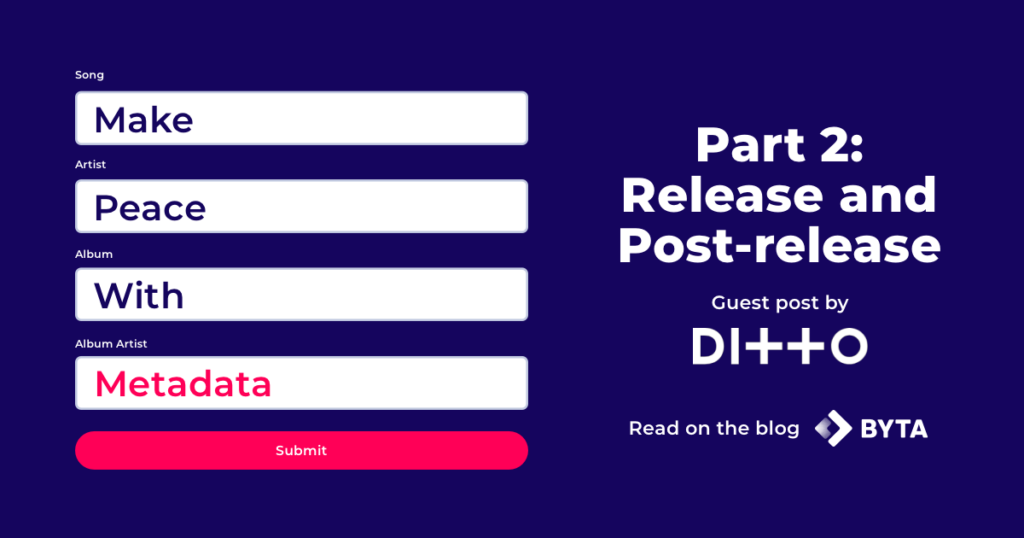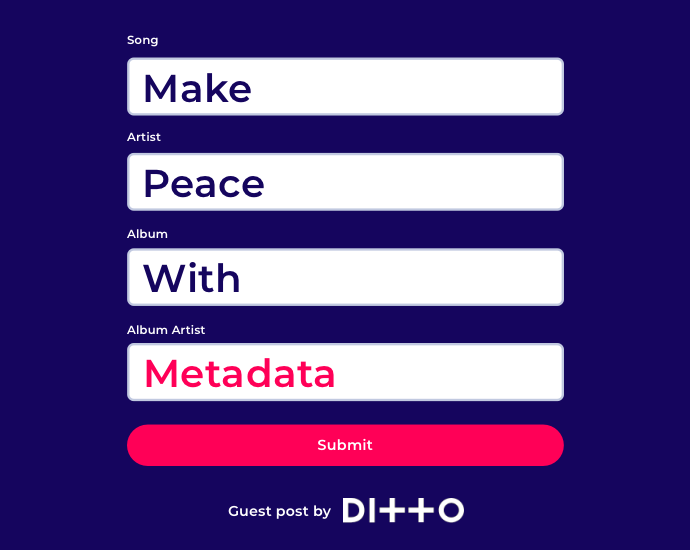Efficient music metadata handling plays a hugely important role in the overall success of your music releases. Correctly entering, transferring and managing your metadata throughout your career as an artist will make it easier to get your music on Spotify, boost your discoverability and ultimately leave you in a better financial – and less stressful – position.
As discussed last time around, inputting the correct metadata and track information to all relevant outlets is essential in the pre-release stage of your journey, allowing you to effectively share correct data with fellow collaborators, media sources and publishing companies.
In today’s edition, we’re going to cover how the correct handling of metadata is equally as vital to your success as an artist once your song or album has been fully released.
Metadata pays the bills
One of the biggest metadata-based considerations during your release and post-release phase will be how you go about generating and managing your royalties.
Now more than ever, it’s vital that artists are personally taking good care of their careers and handling important tasks and data with due diligence. Being accurate with your metadata literally pays off – putting more money in your pockets.
Also playing an essential role within the pre-release stage, correct metadata entry makes your music discoverable, in turn affecting your standard royalties and publishing royalties you should receive for your work. Without correct metadata attached to your music, you run the risk of not receiving the proper credit for your streams and losing out on your hard-earned cash.
Good metadata management can lead to you landing a coveted sync placement too. Make sure that all of your metadata is present and correct in order to be eligible for pitching for sync. All composer and co-writer names must be correct and sent to your publisher so that the licence can be easily cleared and approved.
Applying a professional approach towards your music comes hand in hand with efficiently managing your metadata. Post-release of your music, you’ll need to log into your streaming platform accounts and double (even triple) check that your songs are displaying the correct credits and metadata information.
If things are looking a bit off, some information was likely inaccurate or missing when you uploaded your music. If you notice this on your catalogue, then you’ll need to get in touch with the company that distributed your work to the digital music services. This will normally be your record label or an independent digital distributor like Ditto Music.
Waterfall release strategy
Another post-release scenario where accurate metadata entry comes into play is if you choose to apply a waterfall release strategy to your campaign.
A waterfall release strategy is when an EP or album has the appearance of being released gradually, with one track added at a time until the full release is made available when the final track is added.
The waterfall release strategy is most effective when uploaded to Spotify, as the streaming platform allows your latest release on your artist page to be replaced by multiple releases over time – each time updating and displaying your most recent track at the top of your page.
Because you’re using the same metadata, whenever a song is played on any one of your ‘new’ singles, it all counts towards the overall stream count of that track as Spotify sees it as the same track. It also means that each time you release a new single, you guarantee yourself more streams for the previously released singles, as they’ll automatically play after your listeners check out the newest track if they click through to your latest release.
The waterfall strategy also helps you maximise your chances of being listed on popular playlists such as Discover Weekly. As you’re only able to pitch one track from a forthcoming release to Spotify for Artists for playlist consideration, by utilising this waterfall method, you’re putting multiple releases forward for review and maximising your chance of potential playlist inclusion by the Spotify editors.
Check out our video on how to effectively implement the waterfall release strategy to your campaigns below:
Sync opportunities
When pitching for sync opportunities, you’ll need to provide all of the essential music metadata information in order to meet the tight deadlines of the sync industry.
Sync companies look for specific sets of data to clear tracks quickly, so to be considered for placement, always include the required rights and contact info for each track.
Rights ownership and clearance contact information are the most important things to include along with your tracks. Your sync metadata should always include:
- The percentage of rights you control for the track – e.g. 50% publishing and 100% master
- Contact details for who licences your track
- All rights holders and the percentage they control
- Song Name – including any featured artists
- Artist, Composer, and Album names
- Year and Genre details
- ISRC Code (if you have it)
If your track is a cover of another song, you’ll also have to provide sync companies with info about the original version like so:
As It Was (Harry Styles cover)
Other useful but not essential info to include in your sync pitches includes:
- BPM (Beats per Minute)
- Track Number
- Disc Number
When it comes to pitching for sync, the key to success is to provide full ownership detail within your metadata information, paired with contact info for who is able to clear your rights. Streamlining the process for all parties gives you a better chance of being pitched – and also makes your life a lot easier.
Moving your metadata
Keeping hold of all metadata information once your music has been released is a habit that you’ll want to fall into. Trust us. This will make your life a lot easier down the line if you ever need to transfer your music over to another distributor.
If you have decided to make a move in search of a fairer deal, then you’ll need to ensure you’re transferring all of your metadata correctly to your chosen new service. Make sure all of your information is properly formatted before you transfer your details over to the new provider.
When exporting your data, you’ll need to tick off some specific details related to your music. Make sure to spell-check and correctly list all:
- Primary and featured artist names
- Composers and producers
- Album and song titles
- Release dates
- ISRC codes
Part of your transfer journey will include the submission of identical music metadata and ISRC codes to the new service. Your ISRC codes are unique to your music and are used by streaming services to identify your tracks and pay out the correct streaming royalties, so getting them right is very important to the health of your bank balance.
Moving your music to a different distributor can throw up a few questions regarding your existing stream numbers and royalties, so making sure you’re collecting your metadata info in a smooth and efficient way gives you one less thing to worry about when making the move.
Ditto Music can help you correctly release your music to more global platforms than anywhere else. Working with Ditto allows you to stay independent and keep complete control of your career, whilst also keeping 100% of your royalties and rights to your music. Check out Ditto to make the most of your metadata and boost your music career.


